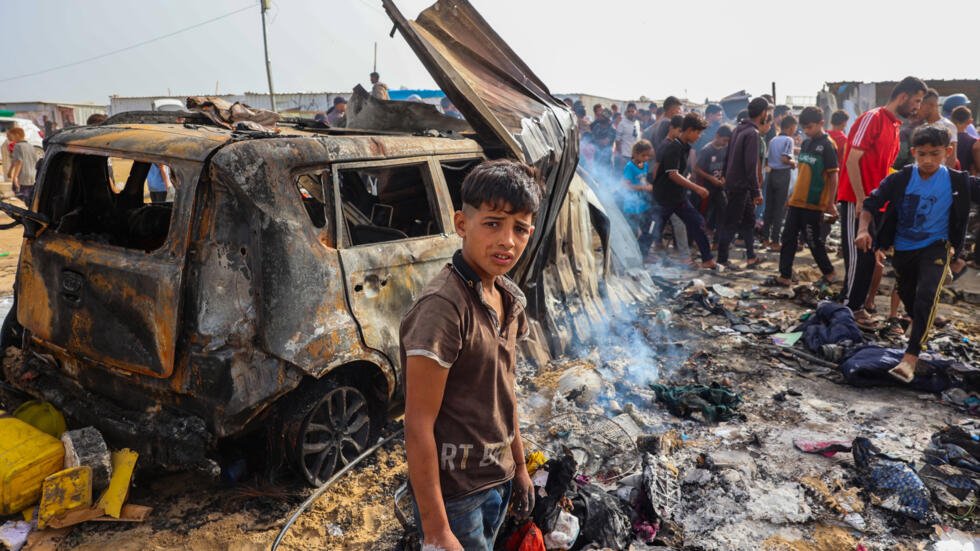In recent weeks, the city of Rafah in Gaza has become the epicenter of escalating violence between Israel and Palestine. The renewed conflict has resulted in significant casualties and widespread destruction, drawing international condemnation. The situation has intensified despite a ruling from the International Court of Justice (ICJ), which called for immediate cessation of hostilities and respect for international humanitarian law.
Global reactions have varied, with some nations and organizations vehemently denouncing the actions, while others have called for restraint and dialogue. The international community remains deeply divided on how to address the ongoing strife, highlighting the complex geopolitical dynamics at play. This blog post will delve into the multifaceted aspects of the conflict, examining the historical context, the humanitarian impact, and the broader implications for regional stability.
Readers will gain an understanding of the reasons behind the recent surge in violence, including key events that have led to the current situation in Rafah. We will explore the responses from various global actors, the role of the ICJ ruling, and the potential paths forward. Through this comprehensive analysis, we aim to shed light on the dire circumstances faced by those in Rafah and the broader ramifications for peace in the region.
Background on Rafah
Rafah, a city situated in the southern part of the Gaza Strip, holds considerable geographical and political significance in the Israeli-Palestinian conflict. Bordering Egypt to the south, Rafah serves as a critical juncture for the movement of people and goods between the Gaza Strip and the outside world. Its strategic location has made it a focal point of contention for both Palestinians and Israelis.
Historically, Rafah has been a center of intense conflict and military operations, heavily influencing the dynamics of the broader Gaza region. During the 1948 Arab-Israeli War, Rafah was incorporated into the Gaza Strip under Egyptian administration. Following the Six-Day War in 1967, Israel took control of the Gaza Strip, including Rafah, leading to a complex and often volatile governance structure.
In the years since, Rafah has been a flashpoint in numerous conflicts, including the First and Second Intifadas. The area is also known for the extensive network of tunnels that have been used to smuggle goods and weapons, making it a critical supply line for Hamas and other militant groups. This has led to frequent Israeli military operations aimed at destroying these tunnels and curbing the flow of arms.
Rafah’s significance is underscored by its role in the broader geopolitical landscape. For Palestinians, the city represents a lifeline to the outside world, especially given the severe restrictions imposed by the Israeli blockade. For Israelis, controlling Rafah is seen as essential to preventing the influx of arms and maintaining security. This dual importance has perpetuated a cycle of conflict and humanitarian crises, with each side viewing control over Rafah as vital to their respective security and sovereignty.
The historical context of Rafah is thus deeply intertwined with the ongoing Israeli-Palestinian conflict. Key events, such as the frequent military operations and the destruction of infrastructure, have shaped the current situation, leading to widespread displacement and suffering among the local population. As tensions continue to escalate, Rafah remains a microcosm of the broader struggles facing the Gaza Strip.
Recent Developments
Recent events have significantly escalated tensions in Rafah, with a series of violent incidents marking the region. Over the past few weeks, Rafah has witnessed a surge in military operations and bombings that have resulted in substantial civilian casualties. The timeline of these events paints a grim picture of the escalating conflict.
One of the most notable incidents occurred on October 12th, when a massive bombing campaign targeted several residential areas in Rafah. The assault led to the destruction of numerous homes and vital infrastructure, leaving many civilians dead or injured. Eyewitnesses reported hearing continuous explosions throughout the night, with rescue operations hampered by the ongoing violence.
Following the bombings, military operations intensified, with ground forces moving into Rafah on October 14th. This led to fierce clashes between the military and local resistance groups, further endangering the civilian population. Reports indicate that several neighborhoods have been subjected to heavy shelling, causing widespread panic and displacement among residents.
The immediate impacts of these events on the local population have been devastating. Hospitals and medical facilities are overwhelmed with casualties, and there is a growing shortage of medical supplies and personnel to treat the injured. Additionally, the destruction of infrastructure has severely disrupted essential services, such as electricity and water supply, exacerbating the humanitarian crisis in Rafah.
The international community has expressed deep concern over the escalating violence in Rafah. Despite global outrage and calls for a ceasefire, the situation remains volatile. The International Court of Justice (ICJ) has issued rulings condemning the ongoing military actions, yet the conflict shows no signs of abating. The people of Rafah continue to endure the hardships brought on by this relentless cycle of violence.
The international reaction to the ongoing conflict in Rafah has been marked by a diverse array of statements, actions, and diplomatic maneuvers from major global players. The United States, a historically pivotal actor in Middle Eastern affairs, has reiterated its call for restraint and emphasized the need for both sides to engage in dialogue. However, the U.S. stance has faced criticism from various quarters, with some arguing that it has not done enough to mediate or halt the violence. Meanwhile, the European Union has issued strong condemnations of the hostilities, urging an immediate ceasefire and the resumption of peace talks. Individual EU member states have also taken varied approaches, with some calling for more stringent measures against those perpetuating the conflict.
The United Nations has been particularly vocal, with the Secretary-General expressing deep concern over the humanitarian implications of the conflict in Rafah. The UN has called for an urgent international response to address the escalating crisis, highlighting the dire need for humanitarian aid and protection for civilians. Additionally, the International Court of Justice’s ruling has added a legal dimension to the international community’s response, though its practical impact remains uncertain amid ongoing hostilities.
Public sentiment around the globe has also been significantly mobilized. Large-scale protests have erupted in numerous cities, with demonstrators calling for an end to the violence and greater international intervention. These protests have often been accompanied by social media campaigns aimed at raising awareness and pressuring governments to take more decisive actions. In certain countries, these movements have prompted legislative bodies to debate potential sanctions or other punitive measures against those responsible for the conflict.
Diplomatic efforts to resolve the situation have been multifaceted. Some nations have dispatched envoys to the region or engaged in shuttle diplomacy in an attempt to broker a ceasefire. Despite these efforts, the path to a sustainable resolution remains fraught with challenges, underscoring the complexity and deeply entrenched nature of the conflict in Rafah.
ICJ Ruling and Its Implications
The International Court of Justice (ICJ) recently issued a ruling addressing the ongoing conflict between Israel and Palestine, particularly focusing on the situation in Gaza. The ICJ, functioning as the principal judicial organ of the United Nations, holds the mandate to settle legal disputes submitted by states and provide advisory opinions on legal questions referred to it by authorized international organs and agencies.
In this ruling, the ICJ found that actions taken by Israel in Gaza contravene several international laws, including those related to humanitarian rights and the laws of armed conflict. The court emphasized that both parties are bound by international legal standards, particularly the Geneva Conventions, which aim to protect civilians during times of war. The ICJ ordered Israel to cease its military operations that target civilian infrastructure and populations, asserting that these actions exacerbate the humanitarian crisis in Gaza. Furthermore, the court recommended that Palestine take necessary measures to prevent attacks on Israeli civilians, urging both sides to return to negotiations to resolve their longstanding disputes.
The implications of the ICJ ruling are multifaceted. Legally, it reinforces the binding nature of international humanitarian laws and underscores the accountability mechanisms in place for violations. The ruling may prompt international entities and member states to increase diplomatic pressure on both Israel and Palestine to comply with these legal mandates. Additionally, it could pave the way for further legal actions, including potential sanctions or referrals to other international bodies, such as the International Criminal Court (ICC), for investigations into alleged war crimes.
For future conflicts in the region, the ICJ ruling serves as a precedent, illustrating the international community’s stance on the adherence to humanitarian laws. It highlights the necessity for all parties in a conflict to prioritize civilian protection and adhere to legal norms. This ruling may also influence international diplomatic efforts to broker peace and stability in Gaza and the broader Israeli-Palestinian conflict.
Humanitarian Impact
The ongoing conflict in Rafah has precipitated a dire humanitarian crisis, deeply affecting the lives of countless civilians. The constant bombardment has led to widespread displacement, with thousands of families forced to flee their homes in search of safety. According to recent reports, over 50,000 residents have been displaced, exacerbating the already critical situation in refugee camps.
The human cost of the conflict is starkly evident in the growing number of casualties. Medical facilities in Gaza report that, to date, the conflict has resulted in over 1,200 fatalities, including a significant proportion of women and children. Additionally, more than 5,000 individuals have sustained injuries, overwhelming the limited healthcare services available in the region. The stories of those affected paint a harrowing picture: families torn apart, children left orphaned, and communities struggling to cope with the trauma.
International aid organizations have mobilized to provide essential assistance, yet they encounter numerous challenges in delivering aid effectively. The blockade and restrictions on movement complicate the transportation of medical supplies, food, and clean water to those in desperate need. Humanitarian workers on the ground face significant risks, including targeted attacks and the constant threat of shelling, which hinder their ability to offer aid.
Organizations such as the Red Crescent and Médecins Sans Frontières are striving to mitigate the impact of the conflict by setting up emergency medical clinics and distributing relief supplies. However, the scale of the crisis far exceeds the resources currently available. Despite global outrage and calls for a ceasefire, the humanitarian situation in Rafah remains precarious, with civilians bearing the brunt of the ongoing violence.
The international community’s response is critical in addressing the immediate needs of those affected and in working towards a sustainable resolution that ensures the safety and well-being of Rafah’s residents. As the conflict continues, the importance of humanitarian aid and the challenges it faces must remain at the forefront of global attention.
Media Coverage and Public Opinion
The conflict in Rafah has garnered extensive media coverage from outlets worldwide, each presenting varying narratives that shape public opinion differently. Major Western media platforms, such as CNN and BBC, have predominantly highlighted the humanitarian crisis, focusing on the devastation in Gaza City and the civilian toll. Their reports often emphasize the global outrage and the recent International Court of Justice (ICJ) ruling against the military actions, portraying a narrative that is critical of the ongoing bombardment.
Conversely, media outlets based in Israel, like The Jerusalem Post and Haaretz, present a contrasting perspective. These sources underscore the security threats posed by militant groups in Gaza, justifying the military response as a necessary measure to protect Israeli citizens. This narrative aims to garner domestic and international support for Israel’s actions, emphasizing the right to self-defense amidst escalating tensions.
Arab and Middle Eastern news organizations, such as Al Jazeera and Al Arabiya, offer yet another viewpoint. Their coverage is deeply rooted in the regional context, often highlighting the historical grievances and the plight of Palestinians. These outlets tend to frame the conflict as a continuation of long-standing oppression, with extensive reporting on the civilian casualties and destruction in Rafah, thereby influencing public opinion to empathize with the Palestinian cause.
The influence of media on public opinion is profound, as the portrayal of events can significantly sway perceptions. Notable biases and discrepancies are evident in the reporting of different outlets. For instance, the language used to describe actors in the conflict—whether termed as ‘militants’ or ‘freedom fighters’—can drastically alter the narrative. Similarly, the focus on specific aspects, such as humanitarian impact versus security threats, further accentuates these biases.
Ultimately, the diverse media coverage on the conflict in Rafah underscores the power of narrative framing in shaping public discourse. As audiences consume information from their preferred sources, their understanding and opinions of the situation are inevitably colored by the inherent biases and perspectives presented by these media outlets.
Potential Paths to Resolution
The conflict in Rafah, a flashpoint in the broader Israeli-Palestinian conflict, calls for multifaceted solutions that can address the root causes and immediate concerns. Diplomacy, ceasefires, and negotiations stand as pillars in the quest for peace. Each path offers distinct advantages and challenges, requiring careful consideration from all involved parties.
Diplomatic efforts often form the backbone of conflict resolution. The international community, including entities like the United Nations and the European Union, plays a critical role in mediating discussions and proposing frameworks for peace. Over the years, numerous peace plans have been tabled, such as the Oslo Accords and the more recent Abraham Accords, which aimed to normalize relations between Israel and certain Arab nations. These initiatives highlight the potential for diplomacy to pave the way to lasting peace, provided there is mutual willingness to compromise.
Ceasefires serve as immediate measures to halt violence and provide a window for dialogue. Temporary truces, often brokered by international mediators, can create essential pauses in hostilities, allowing humanitarian aid to reach affected populations and giving negotiators time to work on more permanent solutions. While ceasefires are not long-term solutions in themselves, they are crucial in reducing immediate suffering and laying the groundwork for more comprehensive peace talks.
Negotiations between Israeli and Palestinian leaders are essential for any sustainable resolution. Both sides must address core issues such as territorial disputes, the status of Jerusalem, and the right of return for Palestinian refugees. Recent efforts have seen varying degrees of success, with some negotiations stalling over contentious points. However, ongoing dialogue remains vital. The perspectives of both Israeli and Palestinian leaders need to be considered to reach a mutually acceptable agreement. Initiatives like the two-state solution have been repeatedly proposed, emphasizing the need for innovative and flexible approaches to break the deadlock.
International proposals and peace initiatives continue to evolve, reflecting the dynamic nature of global geopolitics. The involvement of major powers such as the United States, Russia, and regional actors like Egypt and Jordan underscores the complexity and importance of finding a path to peace in Rafah. These stakeholders can offer support through mediation, economic aid, and political pressure, contributing to a broader coalition working towards stability in the region.
Conclusion
The ongoing conflict in Rafah and Gaza City has been marked by intense violence, despite widespread international condemnation and rulings from the International Court of Justice (ICJ). The situation remains complex, with both historical grievances and present-day political dynamics fueling the strife. The bombardment of Gaza by Israeli forces, coupled with the humanitarian crisis endured by the Palestinian population, underscores the urgent need for a comprehensive and lasting resolution.
Efforts to mediate peace have faced numerous obstacles, including deep-seated mistrust and divergent interests among the involved parties. The international community’s response has been varied, with some nations and organizations calling for immediate cessation of hostilities and others emphasizing the right to self-defense. This divergence highlights the challenges in crafting a unified approach to peace and stability in the region.
It is crucial for individuals to remain informed about the developments in Rafah and Gaza City, understanding the broader context of the conflict. Engaging with credible news sources, following updates from international human rights organizations, and participating in informed discussions can foster a more nuanced comprehension of the issues at play.
Moreover, there are ways to contribute to humanitarian efforts aimed at alleviating the suffering of those affected by the conflict. Supporting reputable charities and non-governmental organizations (NGOs) that provide medical aid, food, and shelter to displaced populations can make a tangible difference. Additionally, advocating for peaceful solutions through policy engagement and public discourse can help amplify the call for a negotiated and sustainable resolution.
The situation in Rafah and Gaza City is a reminder of the complexities inherent in geopolitical conflicts. Achieving lasting peace requires persistent efforts, empathy, and a commitment to justice and human rights. By staying informed and actively participating in humanitarian and peace-building initiatives, individuals can contribute to a more hopeful future for the region.










